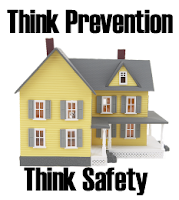 |
| Safety in the Home |
It is unfortunate that we tend to be more reactive than preventive in many areas of our lives. With that in mind let’s change that pattern and think “PREVENTION” first. Have you asked yourself "what are some things we can or should do to prevent accidents in my home?" Instead of pondering over what can or should be done let's take a few steps towards prevention by creating a checklist and taking care of what is deemed in need of ensuring a safer environment.
My disclaimer: by no means am I saying this list is complete but let it serve as a start as they are merely suggestions to assist in the creation of a checklist / action list.
After performing a little research and taking my own living space into consideration, let’s begin with the bathroom which is considered the most hazardous room in the home. Now that I think about it I have actually fallen twice in the bathroom i.e., the bathtub / shower in the last three years. I did not slip I just lost my balance and both times the shower curtains helped break the fall. Fortunately, I was not injured but grab bars would have served a purpose in both instances. Well, enough about my experiences, let’s get started with the list of ideas, tips and things to consider:
 |
| Safety in the Bathroom |
- Water temperature should be less than 120 degrees, of course this is not restricted to the bathroom but throughout the house.
- Grab bars – if needed, they should be placed near the toilet and in the tub / shower.
- Also consider towel bars being used as a grab bar (make sure they can support the weight of the heaviest person in the home).
- If using a shower curtain (think safety first and for those who want that “cute” or “pretty” look use a thick shower liner behind the sheer or decorative outer curtain).
- NOTE: I recommend having the towel bars and curtain rod installed by a professional.
- Area rugs and floor mats – consider removing
them (wow, I am just on the third item and find that I am having dialogue with
myself, I hear some of you asking "why should I get rid of my rugs / mats...?" and presenting alternatives such as using rugs / mats that have non-slip backing … hmmm I will need input from my wife, so I will put
this on hold until she can add another perspective. I realize sometimes we do not take into consideration the time and effort that goes into
coordinating and getting the right items to create that certain look, the perfect
decor…so to just get rid of something that may have taken weeks of planning and searching to find is not always that simple or easy to DO).
OK, I consulted with my wife, the more experienced caregiver who has over 20 years of experience, her advice is if you do not want to remove the rugs / mats use double-sided tape to secure the edges to lessen the risk of tripping on the edge and potentially having the rug skid.
- Personal tip: If you are caring for a senior or someone with Alzheimer's consider purchasing toothpaste with non-removable flip-top. I observed a loved one, who had Alzheimer's, spend nearly a half hour searching for her toothpaste top, but also keep in mind the toothpaste top could potentially wind up on the floor and become the cause of an injury from a fall. Try not to overlook simple things.
- Non-slip mat for tub or shower floor.
- Make it easy to identify hot and cold faucet handles by using colored labels normally blue represents cold and red represents hot.
- Is there a need for elevated or raised toilet seat?
- Do you have non-slip footwear available for slippery surfaces? Or consider professionally installed carpeting to cover slippery floors. OMGoodness, I had no idea how difficult it would be to not elaborate on each of these.
- If you are not alone slow down and make sure the water in the tub / shower has drained completely before exiting.
- Is it difficult for someone in the residence to step into or out of the tub? Consider grab bars (sorry for being redundant), a bench, bath chair or installing an easy access tub / shower.
 |
| Safety in the Kitchen |
- Smoke detectors – are they working, test them regularly, please.
- Fire extinguishers – a good source for information is the National Fire Protection Association.
- Avoid putting flammable objects near open flame.
- Ovens particularly electric can be very hazardous, use caution when inserting and removing especially if you use the broiler.
- Hot grease can be a serious hazard, be extremely careful and take steps to avoid splatters or unsupervised access to the area.
- Do not leave the kitchen unattended while cooking, even when using the microwave.
- Knives – keep them sharp, sharpened knives are better than dull knives; kitchen tips from life hacker.
- Check for items that are unstable, such as table or chair legs that screw in, make sure they are securely screwed in.
- Use of step stools or step ladders.
- Door levers vs. door knobs and other tips: http://www.ilresources.org/assist.php.
- Stoves – consider safety stove and oven control covers.
One helpful source: National Center for Injury Prevention and Control
Contact the Caregivers to arrange a home safety assessment from a professional point of view.
Contact the Caregivers to arrange a home safety assessment from a professional point of view.
Caregiver Tim

No comments:
Post a Comment